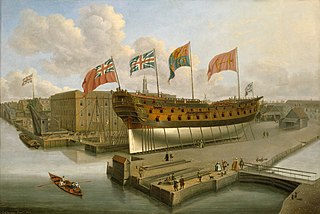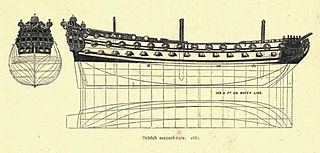
A ship of the line was a type of naval warship constructed during the Age of Sail from the 17th century to the mid-19th century. The ship of the line was designed for the naval tactic known as the line of battle, which involved the two columns of opposing warships maneuvering to volley fire with the cannons along their broadsides. In conflicts where opposing ships were both able to fire from their broadsides, the faction with more cannons firing – and therefore more firepower – typically had an advantage.

In the rating system of the Royal Navy, a third rate was a ship of the line which from the 1720s mounted between 64 and 80 guns, typically built with two gun decks. Years of experience proved that the third rate ships embodied the best compromise between sailing ability, firepower, and cost. So, while first-rates and second-rates were both larger and more powerful, third-rate ships were the optimal configuration.

In the rating system of the Royal Navy used to categorise sailing warships, a first rate was the designation for the largest ships of the line. Originating in the Jacobean era with the designation of Ships Royal capable of carrying at least 400 men, the size and establishment of first-rates evolved over the following 250 years to eventually denote ships of the line carrying at least 80 guns across three gundecks. By the end of the eighteenth century, a first-rate carried no fewer than 100 guns and more than 850 crew, and had a measurement (burthen) tonnage of some 2,000 tons.

In the 18th century and most of the 19th, a sloop-of-war in the Royal Navy was a warship with a single gun deck that carried up to eighteen guns. The rating system covered all vessels with 20 guns and above; thus, the term sloop-of-war encompassed all the unrated combat vessels, including the very small gun-brigs and cutters. In technical terms, even the more specialised bomb vessels and fireships were classed as sloops-of-war, and in practice these were employed in the sloop role when not carrying out their specialised functions.

In the rating system of the Royal Navy used to categorise sailing warships, a second-rate was a ship of the line which by the start of the 18th century mounted 90 to 98 guns on three gun decks; earlier 17th-century second rates had fewer guns and were originally two-deckers or had only partially armed third gun decks. A "second rate" was the second largest class of warships in a hierarchical system of six "ratings" based on size and firepower.

In the rating system of the Royal Navy used to categorise sailing warships, a fifth rate was the second-smallest class of warships in a hierarchical system of six "ratings" based on size and firepower.

In the rating system of the Royal Navy used to categorise sailing warships, a sixth-rate was the designation for small warships mounting between 20 and 28 carriage-mounted guns on a single deck, sometimes with smaller guns on the upper works and sometimes without. It thus encompassed ships with up to 30 guns in all. In the first half of the 18th century the main battery guns were 6-pounders, but by mid-century these were supplanted by 9-pounders. 28-gun sixth-rates were classed as frigates, those smaller as 'post ships', indicating that they were still commanded by a full ('post') captain, as opposed to sloops of 18 guns and less, which were under commanders.

The rating system of the Royal Navy and its predecessors was used by the Royal Navy between the beginning of the 17th century and the middle of the 19th century to categorise sailing warships, initially classing them according to their assigned complement of men, and later according to the number of their carriage-mounted guns. The rating system of the Royal Navy formally came to an end in the late 19th century by declaration of the Admiralty. The main cause behind this declaration focused on new types of gun, the introduction of steam propulsion and the use of iron and steel armour which made rating ships by the number of guns obsolete.

HMS Cornwall was a 74-gun third-rate Vengeur-class ship of the line built for the Royal Navy in the 1810s. She spent most of her service in reserve and was converted into a reformatory and a school ship in her later years. The ship was broken up in 1875.
The Endymion class was a class of six Royal Navy 40-gun fifth-rate frigates, with the prototype launched in 1797 and five slightly amended versions built of fir launched from 1813 to 1814.

HMS Magnanime was a 64-gun third-rate ship of the line of the Royal Navy, launched on 14 October 1780 at Deptford Dockyard. She belonged to the Intrepid-class designed by Sir John Williams and later was razeed into a 44 gun frigate.

HMS Gloucester was a 74-gun, third rate Vengeur-class ship of the line built for the Royal Navy in the 1810s. She played a minor role in the Napoleonic Wars and was cut down into a 50-gun fourth rate frigate in 1831–32. The ship was converted into a receiving ship and broken up in 1884.

HMS Vindictive was a 74-gun third-rate ship of the line of the Royal Navy, built by Nicholas Diddams at Portsmouth Dockyard and launched on 30 November 1813 at Portsmouth.
HMS Falmouth was a 50-gun fourth-rate ship of the line built for the Royal Navy in the first decade of the 18th century. The ship participated in several battles during the War of the Spanish Succession (1701–15) and the War of Jenkins' Ear (1739–48).

HMS Gloucester was a 50-gun fourth-rate ship of the line built at Deptford by Joseph Allin the elder for the Royal Navy in 1710/11. She participated in the War of the Spanish Succession. The ship was burned to prevent capture after she was damaged in a storm during Commodore George Anson's voyage around the world in 1742.

HMS Milan was a 38-gun fifth rate frigate of the Royal Navy. She had previously been Ville de Milan, a 40-gun frigate of the French Navy, but served for only a year before being chased down and engaged by the smaller 32-gun frigate HMS Cleopatra. Ville de Milan defeated and captured her opponent, but suffered so much damage that she was forced to surrender without a fight several days later when both ships encountered HMS Leander, a British fourth rate. Milan went on to serve with the Royal Navy for another ten years, before being broken up in 1815, after the conclusion of the Napoleonic Wars.

Post ship was a designation used in the Royal Navy during the second half of the 18th century and the Napoleonic Wars to describe a sixth-rate ship that was smaller than a frigate, but by virtue of being a rated ship, had to have as its captain a post captain rather than a lieutenant or commander. Thus ships with 20 to 26 guns were post ships, though this situation changed after 1817.
HMS Newcastle was a 50-gun fourth rate of the Royal Navy which saw service in the Napoleonic Wars and the War of 1812.

HMS Janus was a 44-gun Roebuck-class fifth rate of the Royal Navy.

HMS Arethusa was a 46-gun Leda-class fifth-rate frigate built for the Royal Navy during the 1810s. The ship was never commissioned and was converted into a lazarette in 1836. She was renamed HMS Bacchus in 1844 and was further converted into a coal hulk in 1851–52. The ship was sold for scrap in 1883.


















